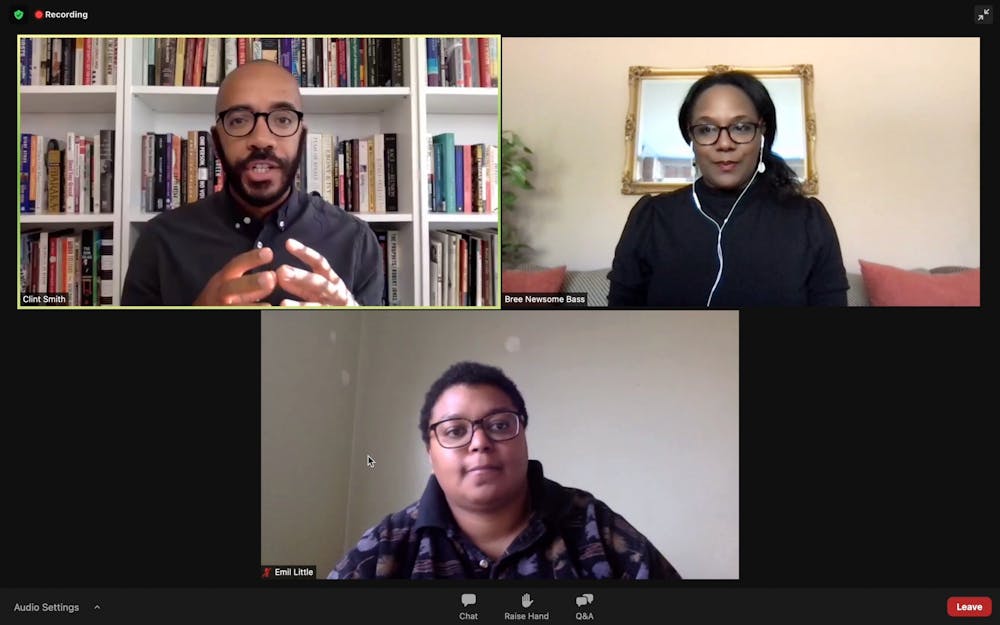The Democracy Initiative hosted a virtual event Tuesday afternoon to discuss the “Lost Cause” myth of the Civil War. The event was part of the Democracy Initiative’s Memory Project, which aims to take an active role in examining the past as it relates to the legacy of enslavement.
The event featured Black activists Bree Newsome Bass and Emil Little and Jalane Schmidt, director of the Democracy Initiative’s Memory Project and associate professor of religious studies. The discussion was moderated by Clint Smith, staff writer for The Atlantic.
Newsome, an American filmmaker, musician, speaker and activist from North Carolina, climbed the flagpole outside of the South Carolina state capital to take down its Confederate flag after the Charleston Massacre on June 17, 2015, whe nine Black individuals were killed during Bible study at Emanuel African Methodist Episcopal Church — one of the oldest Black churches in the U.S. and the host of several civil rights events in the past.
Given the publicity that Newsome brought by scaling the flagpole, Nikki Haley, former governor of South Carolina, signed legislation removing the flag from the grounds of the state capitol.
Little is an anti-racist activist originally from Columbus, Ohio who became known for her protest against Confederate symbology at the University of North Carolina at Chapel Hill. In April 2018, Little smeared her own blood and red ink on the Silent Sam monument, a bronze statue of a Confederate soldier formerly located at the entrance of the Chapel Hill campus.
Schmidt opened the event by explaining the “Lost Cause” narrative, the misleading ideology that the secession of Confederate states during the Civil War was for a heroic cause and had nothing to do with enslavement. Schmidt said this narrative has shaped “the public memory of the Civil War and the reason for the nation's intractable conflict over slavery.”
A scholar-activist, Schmidt has led efforts to contextualize and remove Confederate statues and address public memory in Charlottesville. In 2018, Schmidt and Andrea Douglas, executive director of the Jefferson School African American Heritage Center and former University professor, began leading historical tours to contextualize Charlottesville’s Confederate statues. Schmidt was also involved in the campaign to overturn the state law that had previously prohibited localities from removing these monuments.
Schmidt highlighted the important roles of Bass and Little, who have spoken out against the Confederate “Lost Cause” narrative in addition to attempts to erase Black agency and redeem white supremacist violence.
Smith began the conversation by asking the guest speakers what led them to take these actions. Newsome said it was the government’s “disregard” for the lives of Black people following the massacre, noting that she and other activists questioned whether they should wait for South Carolina to go through its legislative process to take down the flag but decided they should not, given that they believed the process was “invalid.”
“The decision that led to the raising of the flag in the first place was invalid — its all white legislature that made this decision at a time when Black people didn't have voting protection and couldn't really have a say,” Newsome said. “This idea that we had to wait for two-thirds of the legislature to essentially decide that our lives matter, there wasn't indignity to that at all and so, we felt that that was the exact kind of situation where you take direct action.”
Little said her protest against the Silent Sam statue stemmed from her experience while a student at UNC.
“You're walking on a campus where people are using your face for diversity, posters for admissions in their buildings that you're studying in, where you're eating, and they're named after people who would have lynched you, who's made their money on the sale of Black children,” Little said. “That profound contradiction really affected me,” Little said.
Smith also asked Newsome and Little what kinds of images and iconography they envision when they think of new monuments. Newsome noted that Confederate monuments were just as “much about establishing a modern system of structural racism, as it was ever about any kind of historical real historical remembrance.” Newsome added that she “loves” the idea of reevaluating how communities use public spaces to memorialize things.
“How are we honoring the idea of humanity itself?” Newsome said. “How are we creating spaces that are really open and inviting to everyone and in ways that everyone can use?”
The group’s conversation surrounding the removal of Confederate statues led to discussion about the “Unite the Right” rally in Aug. 2017, when hundreds of white supremacists traveled to Charlottesville to protest City Council’s vote to remove the Robert E. Lee statue. Following years of advocacy, the statues of Robert E. Lee, Thomas “Stonewall” Jackson and George Rogers Clark were removed in July, and a civil trial against the rally’s organizers is currently underway.
Smith also asked Newsome and Little what they thought of the relationship between the holiness attributed to Confederate symbols when they are manifestations of harm. Newsome said this has to do with the dominant culture of “whiteness.”
“I think that the reason that the Confederacy and other things tied to whiteness and white supremacy are able to kind of be held as a sacrament is simply because of the dominant culture,” Newsome said. “When something is the dominant culture, when it is a system that is held in place and normalized through a process of colonization, the status quo is upheld on a daily basis through state sponsored violence.”
The event concluded with a question and answer session with the virtual audience. One audience member asked what models and inspirations Little and Newsome have for their activism.
“For me, it is about the continual struggle of my family,” Newsome said. “But then also this broader struggle of humanity.”
Little said Newsome served as one of her inspirations before she took action on the Silent Sam statue.
“That was a really big push for me,” Little said. “I sat at that statue every day, almost for a year, handing out information. And during that time I was inspired by a lot of anonymous Black people.”







